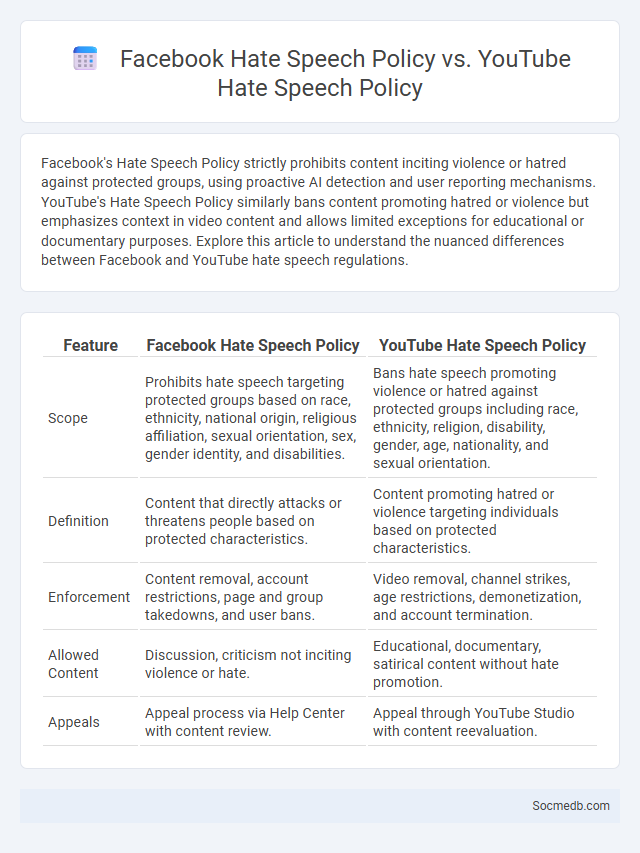
Photo illustration: Facebook Hate Speech Policy vs YouTube Hate Speech Policy
Facebook's Hate Speech Policy strictly prohibits content inciting violence or hatred against protected groups, using proactive AI detection and user reporting mechanisms. YouTube's Hate Speech Policy similarly bans content promoting hatred or violence but emphasizes context in video content and allows limited exceptions for educational or documentary purposes. Explore this article to understand the nuanced differences between Facebook and YouTube hate speech regulations.
Table of Comparison
| Feature | Facebook Hate Speech Policy | YouTube Hate Speech Policy |
|---|---|---|
| Scope | Prohibits hate speech targeting protected groups based on race, ethnicity, national origin, religious affiliation, sexual orientation, sex, gender identity, and disabilities. | Bans hate speech promoting violence or hatred against protected groups including race, ethnicity, religion, disability, gender, age, nationality, and sexual orientation. |
| Definition | Content that directly attacks or threatens people based on protected characteristics. | Content promoting hatred or violence targeting individuals based on protected characteristics. |
| Enforcement | Content removal, account restrictions, page and group takedowns, and user bans. | Video removal, channel strikes, age restrictions, demonetization, and account termination. |
| Allowed Content | Discussion, criticism not inciting violence or hate. | Educational, documentary, satirical content without hate promotion. |
| Appeals | Appeal process via Help Center with content review. | Appeal through YouTube Studio with content reevaluation. |
Overview of Facebook and YouTube Hate Speech Policies
Facebook and YouTube enforce strict hate speech policies to protect users from harmful content targeting race, ethnicity, religion, or other protected characteristics. Your content must comply with these guidelines, which prohibit slurs, dehumanizing language, and calls for violence or discrimination. Both platforms use a combination of AI algorithms and human moderators to detect and remove hateful posts promptly.
Defining Hate Speech: Facebook vs YouTube
Hate speech on social media platforms like Facebook and YouTube involves content that attacks or promotes violence against individuals or groups based on attributes such as race, religion, ethnicity, or sexual orientation. Facebook defines hate speech as direct attacks on protected characteristics, enforcing strict removal policies to maintain community safety. YouTube's approach focuses on removing content that incites hatred or discrimination while balancing freedom of expression, using automated detection combined with human review to moderate effectively. Your understanding of these definitions helps navigate community guidelines and avoid policy violations.
Policy Implementation: Detection and Enforcement Methods
Effective policy implementation in social media hinges on advanced detection and enforcement methods, including AI-driven content analysis and user behavior monitoring. Platforms employ machine learning algorithms to identify harmful or violating content swiftly while leveraging human moderators for nuanced judgment and context verification. Ensuring Your online safety relies on continuous updates to these systems to adapt to emerging threats and maintain community standards.
Community Guidelines: Key Differences and Similarities
Social media platforms enforce Community Guidelines that outline acceptable content and user behavior to ensure safe and respectful interactions. While there are key similarities such as prohibitions on hate speech, harassment, and misinformation, differences arise in content moderation policies, enforcement strictness, and appeal processes across platforms like Facebook, Instagram, Twitter, and TikTok. Understanding these nuances helps users navigate platform-specific standards and maintain compliance effectively.
Content Moderation Strategies on Both Platforms
Effective content moderation strategies on social media platforms prioritize real-time detection of harmful content using AI-powered algorithms and human review teams to ensure accuracy and fairness. You benefit from community guidelines that are transparently enforced, promoting safe interactions while respecting freedom of expression. Implementation of user reporting systems and continuous updates to moderation policies addresses evolving threats and maintains platform integrity.
Appeals and Review Processes for Flagged Content
Social media platforms implement comprehensive appeals and review processes to ensure that flagged content is evaluated fairly and transparently. Your flagged posts undergo scrutiny by automated systems and human moderators to verify compliance with community guidelines, aiming to protect user rights while maintaining platform safety. Efficient appeals systems empower users to contest decisions, enhance trust, and promote accountability within digital communities.
User Responsibility and Reporting Mechanisms
User responsibility on social media involves maintaining respectful interactions and safeguarding personal information to foster a safe online environment. Reporting mechanisms enable you to quickly flag harmful content, such as harassment, misinformation, or inappropriate behavior, ensuring prompt action by platform moderators. These tools empower users to contribute actively to community safety and uphold platform guidelines.
Transparency and Accountability in Policy Enforcement
Transparency and accountability in social media policy enforcement are crucial for maintaining user trust and platform integrity. Clear communication about content guidelines, consistent application of rules, and accessible appeal processes empower Your understanding of enforcement decisions. Platforms that openly share data on policy violations and moderation efforts demonstrate a commitment to fairness and responsibility in managing online communities.
Impact on User Experience and Freedom of Expression
Social media platforms significantly shape user experience by enabling instant communication, personalized content feeds, and interactive engagement that fosters community building. These platforms also play a crucial role in promoting freedom of expression, allowing users to share ideas, opinions, and creativity globally while navigating challenges such as content moderation and censorship. Understanding your digital presence on social media helps you balance connectivity with the protection of your rights and personal voice in an evolving online landscape.
Future Trends in Hate Speech Moderation on Social Platforms
Future trends in hate speech moderation on social platforms emphasize the integration of advanced artificial intelligence algorithms capable of real-time detection and context analysis. Platforms are increasingly adopting AI-driven content moderation tools that leverage natural language processing and machine learning to identify nuanced hate speech while reducing false positives. Enhanced collaboration between social media companies, policymakers, and civil rights organizations is shaping the development of transparent, ethical moderation frameworks to combat online hate more effectively.
 socmedb.com
socmedb.com